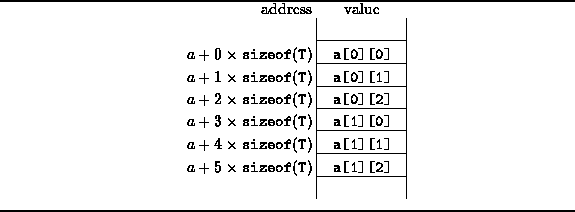The memory of a computer is essentially a one-dimensional array--the memory address is the array subscript.
Therefore, the most natural way to implement a multi-dimensional
array is to store its elements in a one-dimensional array.
In order to do this,
we need a mapping from the n subscript expressions
used to access an element of the multi-dimensional array
to the one subscript expression used to access the one-dimensional array.
E.g., suppose we have a two-dimensional array
of elements of type T, T a[2][3],
the elements of which are to be stored in a one-dimensional array,
T b[20].
Then we need to determine which element of b, say b[k],
will be accessed given a reference of the form a[i][j].
I.e., we need the mapping f such that ![]() .
.
The mapping function determines the way in which the elements
of the array are stored in memory.
The most common way to represent an array is in
row-major order ,
also known as lexicographic order .
E.g., consider the 2D array T a[2][3].
The row-major layout of this array is shown in Figure ![]() .
.

Figure: Row-Major Order Layout of a 2D Array
In row-major layout, it is the right-most subscript expression
(the column index) that increases the fastest.
As a result, the elements of the rows of the matrix
end up stored in contiguous memory locations.
In Figure ![]() ,
the array is stored starting from address a.
The first element of the first row is a address
,
the array is stored starting from address a.
The first element of the first row is a address ![]() .
The first element of the second row is at address
.
The first element of the second row is at address ![]() ,
since there are 3 elements in each row.
,
since there are 3 elements in each row.
We can now generalize this to an arbitrary n-dimensional array.
Suppose we have an n-D array declared as
T a[ ![]() ][
][ ![]() ][
][ ![]() ][
][ ![]() ].
Furthermore, let a be the starting address of the array.
Then, the address of the element
a[
].
Furthermore, let a be the starting address of the array.
Then, the address of the element
a[ ![]() ][
][ ![]() ][
][ ![]() ][
][ ![]() ] is given by
] is given by
where
![]()
The running time required to calculate the address appears to be ![]() since the address is the sum of n terms and for each term
we need to compute
since the address is the sum of n terms and for each term
we need to compute ![]() , which requires O(n) multiplications
in the worst case.
However, the address calculation can in fact be done in O(n) time
using the following algorithm:
, which requires O(n) multiplications
in the worst case.
However, the address calculation can in fact be done in O(n) time
using the following algorithm:
unsigned int product = 1; T* address =; for (int j = n; j >= 1; -j)
address += product *
; product *=
;
This algorithm makes subtle use of the way that address arithmetic is done in C++. Since the variable address is of type T*, it is not necessary to scale the computation by sizeof(T). In C++ whenever an integer value is added to a pointer variable, it is automatically scaled by the compiler before the addition.